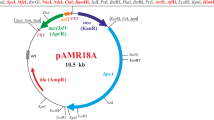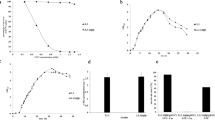Summary
In a class of tunicamycin-resistant mutants (tmrA7) of Bacillus subtilis, the production of extracellular α-amylase is increase by about five fold. The tmrA7 characteristics (tunicamycin resistance and hyperproduction of extracellular α-amylase) can be transferred to recipient cells by transformation. In the transformants and the original tmrA7 mutant, typical amplification of the region from 4 kb upstream of the amyE gene to the tmrB gene on the chromosome was detected. The repeating unit, 16 kb in size, repeats tandemly about five and ten times in the mutant and transformants, respectively, and the α-amylase production is proportional to the copy number of the amyE gene. Simultaneous amplification of the tmrB gene, which is responsible for tunicamycin resistance in the multicopy state, and the α-amylase structural gene (amyE) seems to be the cause of the pleiotropy of the tmrA7 mutation.
Similar content being viewed by others
References
Albertini AM, Galizzi A (1985) Amplification of a chromosomal region in Bacillus subtilis. J Bacteriol 162:1203–1211
Altenbuchner J, Cullum J (1984) DNA amplification and unstable arginine gene in Streptomyces lividans 66. Mol Gen Genet 195:134–138
Anderson RP, Roth JR (1977) Tandem genetic duplications in phage and bacteria. Annu Rev Microbiol 31:473–505
Ayusawa D, Yoneda Y, Yamane K, Maruo B (1975) Pleiotropic phenomena in autolytic enzyme(s) content, flagellation, and simultaneous hyperproduction of extracellular α-amylase and protease in a Bacillus subtilis mutant. J Bacteriol 124:459–469
Edlung T, Normark S (1981) Recombination between short homologies causes tandem duplication. Nature 292:269–271
Fishman SE, Hershberger CL (1983) Amplified DNA in Streptomyces fradiae. J Bacteriol 155:459–466
Fishman SE, Rosteck JR PR, Hershberger CL (1985) A 2.2-kilobase repeated DNA segment is associated with DNA amplification in Streptomyces fradiae. J Bacteriol 161:199–206
Furusato T, Takano J, Yamane K, Hashiguchi K, Tanimoto A, Mori M, Yoda K, Yamasaki M, Tamura G (1986) Amplification and deletion of the amyE+-tmrB gene region in a Bacillus subtilis recombinant-phage geneome by the tmrA7 mutation. J Bacteriol 165:549–556
Fuwa H (1954) A new method for microdetermination of amylase activity by the use of amylose as the substrate. J Biochem 41:583–603
Hashiguchi K, Tanimoto A, Nomura S, Yamane K, Yoda K, Harada S, Mori M, Furusato T, Takatsuki A, Yamasaki M, Tamura G (1985) Gene amplification of the amyE-tmrB region in Bacillus subtilis. Agric Biol Chem 49:545–550
Haas M, Yoshikawa H (1969) Defective bacteriophage PBSH in Bacillus subtilis. 2. Intracellular development of the induced prophage. J Virol 3:248–260
Hitotsuyanagi K, Yamane K, Maruo B (1979) Stepwise introduction of regulatory genes stimulating production of α-amylase into Bacillus subtilis: construction of an α-amylase extrahyper-producing strain. Agric Biol Chem 43:2343–2349
Nomura S, Yamane K, Sasaki T, Yamasaki M, Tamura G, Maruo B (1978) Tunicamycin-resistant mutants and chromosomal locations of mutational sites in Bacilus subtilis. J Bacteriol 136:818–821
Normark S, Edlund T, Grundström T, Wolf-Watz H (1977) Escherichia coli K-12 mutants hyperproducing chromosomal beta-lactamase by gene repetitions. J Bacteriol 132:921–922
Ono H, Hintermann G, Crameri R, Wallis G, Hütter R (1982) Reiterated DNA sequences in a mutant strain of Streptomyces glaucescens and cloning of the sequence in Escherichia coli. Mol Gen Genet 186:106–110
Peterson BC, Rownd RH (1983) Homologous sequences other than insertion elements can serve as recombination sites in plasmid drug resistance gene amplification. J Bacteriol 156:177–185
Piggot PJ, Hoch JA (1985) Revised genetic linkage map of Bacillus subtilis. Microbiol Rev 49:158–179
Robinson M, Lewis E, Napier E (1981) Occurrence of reiterated DNA sequences in strains of Streptomyces produced by an interspecific protoplast fusion. Mol Gen Genet 182:336–340
Rownd RH, Miki T, Appelbaum ER, Miller JR, Finkelstein M, Barton CR (1978) Dissociation, amplification, and reassociation of comoposite R-plasmid DNA. In: Schlessinger D (ed) Microbiology, 1978. American Society for Microbiology, Washington DC, pp 33–37
Saito H, Anzai H, Kawamura F (1983) Multicopy integration vectors in Bacillus subtilis. In: Ikeda Y, Beppu T (eds) International symposium on genetics of industrial microorganisms. Kodansha Ltd, Tokyo, pp 125–130
Sanger F, Nicklen S, Coulson AR (1977) DNA sequencing with chain-terminating inhibitors. Proc Natl Acad Sci USA 74:5463–5467
Sasaki T, Yamasaki M, Maruo B, Yoneda Y, Yamane K, Takatsuki A, Tamura G (1976) Hyperproductivity of extracellular α-amylase by a tunicamycin resistant mutant of Bacillus subtilis. Biochem Biophys Res Commun 70:125–131
Schrempf H (1983) Deletion and amplification of DNA sequences in melanin-negative variants of Streptomyces reticuli. Mol Gen Genet 189:501–505
Shibata T, Saito H (1973) Repair of ultraviolet-induced DNA damage in the subcellular systems of Bacillus subtilis. Mutat Res 20:159–173
Southern EM (1975) Detection of specific sequences among DNA fragments separated by gel electrophoresis. J Mol Biol 98:503–517
Tlsty TD, Albertini AM, Miller JH (1984) Gene amplification in the lac region of E. coli. Cell 37:217–224
Trowsdale J, Anagnostopoulos C (1975) Evidence for the translocation of a chromosome segment in Bacillus subtilis carrying the trpE26 mutation. J Bacteriol 122:886–898
Wilson CR, Morgan AE (1985) Chromosomal DNA amplification in Bacillus subtilis. J Bacteriol 163:445–453
Yamaguchi K, Nagata Y, Maruo B (1974) Genetic control of the rate of α-amylase synthesis in Bacillus subtilis. J Bacteriol 119:410–415
Yamazaki H, Ohmura K, Nakayama A, Takeichi Y, Otozai K, Yamasaki M, Tamura G, Yamane K (1983) α-Amylase genes (amyR2 and amyE +) from an α-amylase hyperproducing Bacillus subtilis strain: Molecular cloning and nucleotide sequences. J Bacteriol 156:327–337
Yang M, Galizzi A, Henner D (1983) Nucleotide sequence of the amylase gene from Bacillus subtilis. Nucleic Acids Res 11:237–249
Yoneda Y, Yamane K, Maruo B (1973) Membrane mutation related to the production of extracellular α-amylase and protease in Bacillus subtilis. Biochem Biophys Res Commun 50:765–770
Yoneda Y (1980) Increased production of extracellular enzymes by the synergistic effect of genes introduced into Bacillus subtilis by stepwise transformation. Appl Environ Microbiol 39:274–276
Young M (1984) Gene amplification in Bacillus subtilis. J Gen Microbiol 130:1613–1621
Author information
Authors and Affiliations
Additional information
Communicated by M. Takanami
Rights and permissions
About this article
Cite this article
Hashiguchi, Ki., Tanimoto, A., Nomura, S. et al. Amplification of the amyE-tmrB region on the chromosome in tunicamycin-resistant cells of Bacillus subtilis . Molec Gen Genet 204, 36–43 (1986). https://doi.org/10.1007/BF00330184
Received:
Accepted:
Issue Date:
DOI: https://doi.org/10.1007/BF00330184




